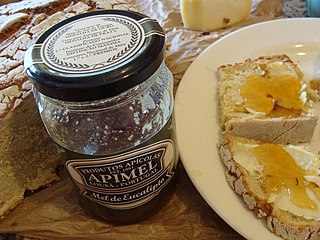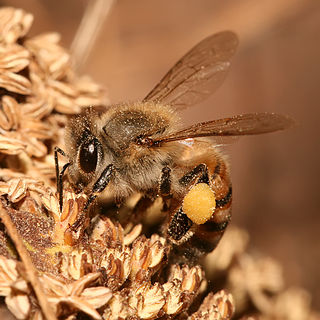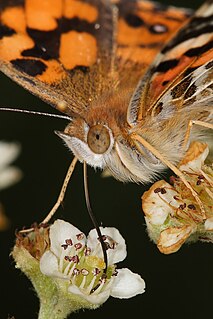Melissopalynology is the study of pollen contained in honey [1] and, in particular, the pollen's source. By studying the pollen in a sample of honey, it is possible to gain evidence of the geographical location and genus of the plants that the honey bees visited, although honey may also contain airborne pollens from anemophilous plants, spores, and dust due to attraction by the electrostatic charge of bees.

Pollen is a fine to coarse powdery substance comprising pollen grains which are male microgametophytes of seed plants, which produce male gametes. Pollen grains have a hard coat made of sporopollenin that protects the gametophytes during the process of their movement from the stamens to the pistil of flowering plants, or from the male cone to the female cone of coniferous plants. If pollen lands on a compatible pistil or female cone, it germinates, producing a pollen tube that transfers the sperm to the ovule containing the female gametophyte. Individual pollen grains are small enough to require magnification to see detail. The study of pollen is called palynology and is highly useful in paleoecology, paleontology, archaeology, and forensics. Pollen in plants is used for transferring haploid male genetic material from the anther of a single flower to the stigma of another in cross-pollination. In a case of self-pollination, this process takes place from the anther of a flower to the stigma of the same flower.
A genus is a taxonomic rank used in the biological classification of living and fossil organisms, as well as viruses, in biology. In the hierarchy of biological classification, genus comes above species and below family. In binomial nomenclature, the genus name forms the first part of the binomial species name for each species within the genus.

A honey bee is a eusocial, flying insect within the genus Apis of the bee clade. They are known for construction of perennial, colonial nests from wax, for the large size of their colonies, and for their surplus production and storage of honey, distinguishing their hives as a prized foraging target of many animals, including honey badgers, bears and human hunter-gatherers. In the early 21st century, only seven species of honey bee are recognized, with a total of 44 subspecies, though historically seven to eleven species are recognized. The best known honey bee is the Western honey bee which has been domesticated for honey production and crop pollination; modern humans also value the wax for candlemaking and other crafts. Honey bees represent only a small fraction of the roughly 20,000 known species of bees. Some other types of related bees produce and store honey and have been kept by humans for that purpose, including the stingless honey bees, but only members of the genus Apis are true honey bees. The study of bees, which includes the study of honey bees, is known as melittology.
Contents
In general, melissopalynology is used to combat fraud and inaccurate labelling of honey. Information gained from the study of a given sample of honey (and pollen) is useful when substantiating claims of a particular source for the sample. Monofloral honey derived from one particular source plant may be more valuable than honey derived from many types of plants. The price of honey also varies according to the region from which it originates.

Monofloral honey is a type of honey which has a distinctive flavor or other attribute due to its being predominantly from the nectar of one plant species. It is stored and labeled separately so as to command a premium price. While there may never be an absolute monofloral type, some honeys are relatively pure due to the prodigious nectar production of a particular species, such as citrus, or there may be little else in bloom at the time.












